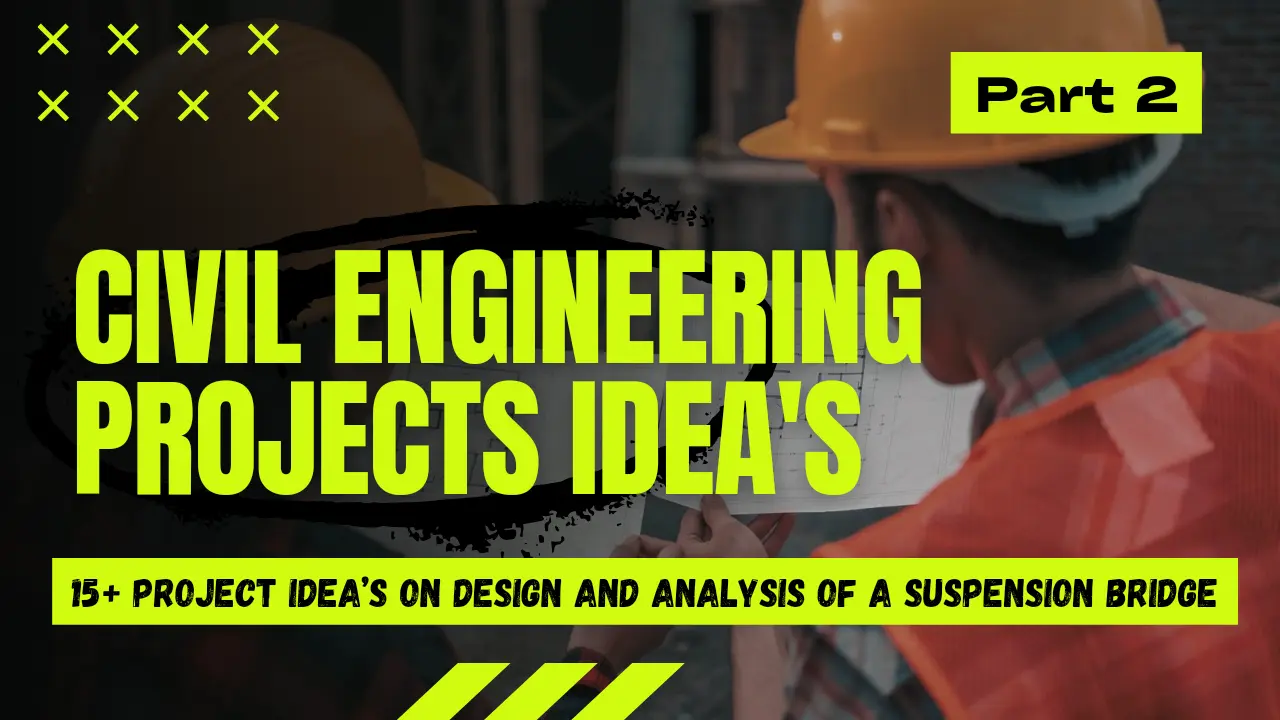Design & Analysis of Suspension Bridge
The design and analysis of suspension bridges are pivotal in modern civil engineering, representing the convergence of aesthetics, functionality, and structural integrity. Suspension bridges, renowned for their graceful curves and expansive spans, are critical infrastructure elements that facilitate transportation across challenging terrains such as deep valleys or wide bodies of water. As cities expand and infrastructure demands increase, ensuring that these bridges are not only visually striking but also resilient and efficient is essential.
With advancements in technology and materials, today’s suspension bridge projects can incorporate cutting-edge solutions to enhance performance and longevity. Innovations such as smart monitoring systems, advanced materials, and computational modeling techniques enable engineers to create bridges that are not only more durable but also more adaptable to future challenges. Addressing issues such as climate change, seismic activity, and energy efficiency, these modern approaches promise to redefine the capabilities and sustainability of suspension bridges.
By exploring new technologies and methodologies, engineers can optimize the design and analysis of suspension bridges to meet the evolving needs of our society while ensuring safety, efficiency, and environmental stewardship. This integration of innovative techniques and materials will play a crucial role in shaping the future of bridge engineering and infrastructure development.
Steps to Create a Successful Project
1. Define Objectives
Clearly outline the goals and objectives of your project. Ensure they are specific, measurable, achievable, relevant, and time-bound (SMART).
2. Conduct Research
Gather information about the project scope, market needs, and potential challenges. Research best practices and gather insights from previous similar projects.
3. Plan and Organize
Create a detailed project plan outlining tasks, deadlines, resources, and responsibilities. Use project management tools to track progress and keep everything organized.
4. Build a Team
Assemble a team with the necessary skills and expertise. Assign roles and responsibilities clearly, and ensure good communication and collaboration within the team.
5. Execute the Plan
Implement the project plan, monitor progress regularly, and adjust as needed. Ensure all tasks are completed according to schedule and within budget.
6. Monitor and Evaluate
Track performance metrics and evaluate the outcomes against the project objectives. Gather feedback, identify lessons learned, and make improvements for future projects.
7. Finalize and Close
Complete any remaining tasks, finalize documentation, and formally close the project. Review the project results and celebrate successes with the team.
Table of Contents
15 Project Idea’s Design and Analysis of a Suspension Bridge
1. Smart Suspension Bridge with Integrated IoT Sensors
- Concept: Design and implement a suspension bridge equipped with Internet of Things (IoT) sensors to monitor structural health in real-time. The sensors can track parameters such as strain, temperature, and vibrations, providing valuable data for predictive maintenance and safety.
- Technology: IoT sensors, data analytics platforms, real-time monitoring systems.
2. Advanced Materials for Enhanced Bridge Durability
- Concept: Research and apply advanced materials such as ultra-high-performance concrete (UHPC) or fiber-reinforced polymers (FRP) to improve the durability and longevity of suspension bridges. Analyze their performance compared to traditional materials.
- Technology: Advanced material science, structural testing, and durability analysis.
3. Dynamic Load Response Analysis Using Machine Learning
- Concept: Develop a machine learning model to predict and analyze the dynamic response of a suspension bridge under various load conditions. The model can help optimize design parameters and enhance bridge safety.
- Technology: Machine learning algorithms, dynamic load analysis software, and data collection systems.
4. Seismic-Resilient Suspension Bridge Design
- Concept: Create a design for a suspension bridge that incorporates innovative seismic-resistant features to withstand earthquakes. Implement technologies such as base isolators or energy dissipation devices.
- Technology: Seismic design software, structural isolation systems, and dynamic simulation tools.
5. Virtual Reality (VR) for Suspension Bridge Design and Simulation
- Concept: Develop a VR simulation platform for the design and analysis of suspension bridges. This tool can be used for immersive design reviews, stakeholder presentations, and educational purposes.
- Technology: VR technology, 3D modeling, and interactive simulation tools.
6. Hybrid Suspension and Cable-Stayed Bridge System
- Concept: Design a hybrid bridge system that combines elements of suspension and cable-stayed technologies to address specific challenges such as span length and load distribution. Analyze the benefits and trade-offs of this hybrid approach.
- Technology: Hybrid structural modeling, advanced design software, and comparative analysis.
7. Energy Harvesting from Bridge Movements
- Concept: Explore methods to harvest energy from the vibrations and movements of a suspension bridge. Design a system to convert kinetic energy into electrical power for use in bridge lighting or sensors.
- Technology: Piezoelectric materials, energy conversion systems, and vibration analysis.
8. Real-Time Structural Health Monitoring with Drones
- Concept: Use drones equipped with high-resolution cameras and sensors to perform regular inspections and health monitoring of suspension bridges. Develop algorithms to analyze drone-captured data for detecting potential issues.
- Technology: Drone technology, image processing algorithms, and structural health monitoring systems.
9. Adaptive Design Techniques for Climate Change Resilience
- Concept: Research and implement adaptive design techniques to make suspension bridges more resilient to the impacts of climate change, such as extreme weather events and rising temperatures. Propose modifications to existing design standards.
- Technology: Climate modeling, adaptive design strategies, and performance simulation tools.
10. Enhanced Bridge Deck Design with Smart Materials
- Concept: Investigate the use of smart materials in the bridge deck to improve performance and safety. This could include materials that change properties in response to environmental conditions or load changes.
- Technology: Smart materials, adaptive structures, and performance monitoring systems.
11. Automated Construction Techniques for Suspension Bridges
- Concept: Develop and test automated construction techniques for building suspension bridges more efficiently and safely. This could include robotics, automated machinery, or advanced prefabrication methods.
- Technology: Robotics, automation technology, and prefabrication techniques.
12. Advanced Computational Methods for Structural Analysis
- Concept: Apply advanced computational methods, such as high-performance computing (HPC) and parallel processing, to improve the accuracy and efficiency of structural analysis for suspension bridges.
- Technology: HPC systems, advanced simulation software, and computational modeling.
13. Integration of Renewable Energy Systems into Bridge Design
- Concept: Explore the integration of renewable energy systems, such as solar panels or wind turbines, into the design of suspension bridges. Analyze the feasibility and benefits of generating sustainable energy on-site.
- Technology: Renewable energy technologies, energy integration systems, and environmental impact assessments.
14. Public Safety and Security Enhancements with Smart Surveillance
- Concept: Implement smart surveillance systems for suspension bridges to enhance public safety and security. This could include real-time video analytics, automated threat detection, and emergency response coordination.
- Technology: Smart surveillance systems, video analytics, and security management tools.
15. Cost-Effective Retrofit Solutions for Aging Suspension Bridges
- Concept: Develop cost-effective retrofit solutions to upgrade and strengthen aging suspension bridges. Focus on techniques that extend the lifespan of existing structures while minimizing disruption.
- Technology: Retrofit design methods, advanced materials, and structural assessment tools.

Hi! I’m Sandip, a civil engineer who loves sharing about Civil Engineering & new ideas and tips. My blog helps you learn about engineering in a fun and easy way!


Comments are closed.